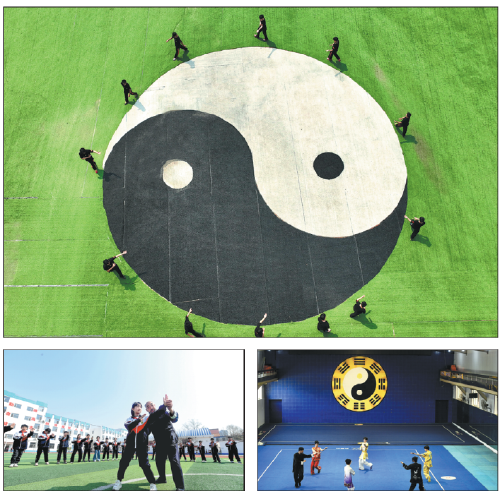Hebei martial art reels in younger adherents
Wenan county has made discipline compulsory part of primary, secondary education to keep legacy alive

On Tuesday afternoons, hundreds of students can be found practicing baguazhang, or eight diagrams palm, in the schoolyard of a primary school in Wenan county in Langfang, Hebei province.
Among them is Xing Moran, who started learning the martial art at the start of this semester.
"When I began, I just wanted to strengthen my body as my parents had suggested, but then I fell in love with the martial art," the 11-year-old said, adding that she is now interested in learning more baguazhang movements.
This form of martial art was founded by another Wenan resident, Dong Haichuan, while Emperor Xianfeng reigned during the Qing Dynasty (1644-1911).
He based the form on the Book of Changes, or I Ching, an ancient Chinese book of divination and a source of Confucian and Taoist philosophy.
The art is known for its spiraling movements and defensive footwork, and relies primarily on open-hand techniques and full-body movements.
Practitioners of baguazhang move in eight directions that represent the eight principle trigrams contained in the Book of Changes. They walk in a circular direction, taking swinging steps while attempting to hook their opponents, and strike them using different hand positions.
It was listed as a national intangible cultural heritage in 2008.
Today, practitioners of the art can be found in some 50 countries and regions, with the number of global practitioners topping 5 million, according to the county government.
In Wenan, about half the county's residents are able to perform some baguazhang movements, and the complicated, elegant moves are part of the martial art's appeal.
As a result of her interest and enthusiasm, Xing is fortunate to be able to practice at school for an hour every Tuesday, along with the other students at the Wenan County No 2 Primary School.
Teaching baguazhang in schools is one of the ways Wenan is passing on traditional Chinese martial arts to the younger generation, and as the place where the style was invented, the county has made it a compulsory course for primary and secondary schools since 2018.
The theory and practice of baguazhang is taught at 25 schools in 13 townships, according to the local government. In addition to schools, there are also baguazhang centers in Wenan that specialize in training professional practitioners.
At the Wenzhu Martial Arts School, one spirited elder teaches every day. Ren Wenzhu is the county's fifth-generation inheritor of baguazhuang and is also the school's president.
Born in 1950, the 73-year-old has practiced baguazhang since he was a child. In 2001, having mastered the style, Ren founded the Wenzhu Martial Arts Center, the school's predecessor.
"As long as my health permits, I will continue to study baguazhang, and pass on all I have learned to my students," he said, adding that he encourages his students to spread awareness of baguazhang around the world.
One of those students is Wang Jiandong, who has now become a sixth-generation inheritor of baguazhuang. Wang has taught the martial art to around 2,000 students from home and abroad.
"The local government has continued to strengthen the inheritance and preservation of baguazhang. It's our responsibility to carry it forward," Wang said.

Today's Top News
- Another sign of Japan's right-wingers' dangerous ambition to break free of all postwar constraints
- Hainan's special customs operations start strong
- Macao SAR holds flag-raising, reception to mark 26th anniversary of return to motherland
- China issues rules to regulate pricing practices of internet platforms
- US hits over 70 IS-linked targets in Syria in massive retaliatory strikes
- Coffee needs cooperation, not confrontation






























